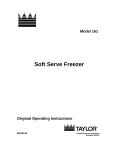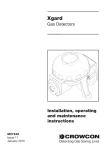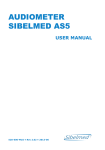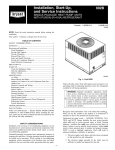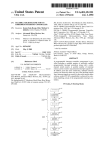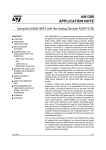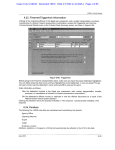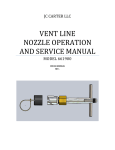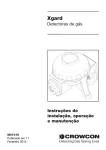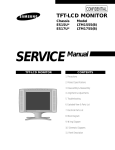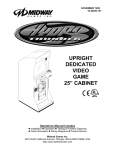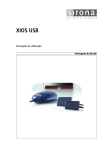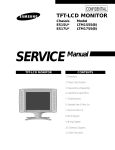Download COSMED Pony Spirometer Service Manual
Transcript
SERVICE MANUAL Pony graphic Corporate Office: COSMED Srl PO Box n °3, Pavona di Albano RM, 00040 -Italy Tel:+39 (06)931.5492 Fax:+39 (06)931.4580 email:[email protected] P/N. C01414-01-91 / Date of Issue: January 2002. North American Office: COSMED USA,Inc. 2758 North Paulina Street, Chicago,IL 60614 USA Phone:+1 (773)528-8113 Fax:+1 (773)528-8116 email:[email protected] No part of this manual may be reproduced or transmitted in any form without the express permission of COSMED srl. COSMED does not assume the liability for mistakes in this documentation or for casual or consequential damages in connection with the provision, representation or use of this documentation. This manual has been compiled by means of Adobe Page Maker 6.5 , Microsoft Word, Corel Draw and CAD programs. COSMED Software can be installed only in one device. Word and Excel are registered trade marks of Microsoft Corporation. DBIII is a registered trade mark of Bordland International Inc. Lotus 123 is a registered trade mark of Lotus Development Corporation. Page Maker is a registered trade mark of Adobe Corporation. Corel Draw! is a registered trade mark of Corel Corporation Pony graphic service Manual October 2001 II Edition Copyright © 1998 COSMED COSMED Srl - Italy Part No. C01414-01-91 Rev A. WARNING Do not use the equipment in presence of flammable gases or anesthetic mixtures. Perform the service procedures described in this manual only if you are a trained and authorized COSMED service person. Keep the equipment away from heat, flames, sparks, flammable liquid mixtures and explosive gases. For using this equipment along with other medical ones, contact COSMED. The following symbols are used into the equipment, in accordance of the actual standards: Type B equipment (according to EN60601-1) DANGER: high temperature OFF ON Protective earth AC WARNING Perform the service procedures described in this manual only if you are a trained and authorized COSMED service person. You must have a through knowledge and experience with medical electronic equipment. Pay attention to the directions in this service manual, along with the warning and cautions that appear throughout this manual. Read through each step in every procedure before beginning the repair. Always use the proper tools, test equipment and the most recent revision of this service manual. Warning If you deviate from the instructions and/or recommendations in this manual, you may cause the Pony Graphic to operate improperly or unsafely, and you may damage the Pony Graphic itself. The Pony Graphic User's Manual is an integral companion to this manual. Familiarize yourself with it before operating and repairing the device. Table Of Contents 1. Introduction.......................................................................................... 1.2 1.1. Organisation of the manual ......................................................................................... 1.2 1.2. Reference Documents .................................................................................................. 1.2 1.3. Customer Communication........................................................................................... 1.2 1.4. Technical Specifications.............................................................................................. 1.3 1.4.1. Pony graphic Unit .................................................................................................... 1.3 1.4.2. Flow meter ............................................................................................................... 1.3 1.4.3. Power supply: .......................................................................................................... 1.3 1.4.4. Battery charger ........................................................................................................ 1.3 1.4.5. Windows PC Software............................................................................................. 1.3 1.4.6. PC configuration required........................................................................................ 1.3 1.4.7. Safety and conformity .............................................................................................. 1.3 2. Functional description ........................................................................ 2.2 2.1. General Overview.......................................................................................................... 2.2 2.1.1. Pony graphic Unit .................................................................................................... 2.2 2.1.2. Flowmeter ................................................................................................................ 2.2 2.1.3. Battery Charger (AC /DC Adapter) .......................................................................... 2.2 2.1.4. RS232 cable ............................................................................................................ 2.2 3. Part Description ................................................................................... 3.2 3.1. Pony graphic Unit ......................................................................................................... 3.3 3.2. Mother Board (C01350-01-15) ...................................................................................... 3.3 3.2.1. Function ................................................................................................................... 3.3 3.2.2. Description............................................................................................................... 3.3 3.2.3. Adjustments & checks ............................................................................................. 3.4 3.2.4. Assembly Drawing ................................................................................................... 3.4 3.2.5. Warnings & Indications in Event of Failure.............................................................. 3.4 3.3. Display Assembly (C01344-01-30)............................................................................... 3.5 3.3.1. Function ................................................................................................................... 3.5 3.3.2. Description............................................................................................................... 3.5 3.3.3. Adjustments & checks ............................................................................................. 3.5 3.3.4. Assembly Drawing ................................................................................................... 3.5 3.3.5. Warnings & Indications in Event of Failure.............................................................. 3.5 3.4. Keyboard Assembly (C01352-01-15)........................................................................... 3.5 3.4.1. Function ................................................................................................................... 3.5 3.4.2. Description............................................................................................................... 3.5 3.4.3. Adjustments & Checks ............................................................................................ 3.5 3.4.4. Assembly Drawing ................................................................................................... 3.6 3.4.5. Warnings & Indications in Event of Failure.............................................................. 3.6 3.5. Printer (C01386-01-08) .................................................................................................. 3.6 3.5.1. Function ................................................................................................................... 3.6 3.5.2. Description............................................................................................................... 3.6 3.5.3. Adjustment & checks ............................................................................................... 3.6 3.5.4. Assembly Drawing ................................................................................................... 3.7 3.5.5. Warnings & Indications in Event of Failure.............................................................. 3.7 Service Manual Ponygraphic Table of Contents i 3.6. Opto Electronic Assembly(C00095-01-05) ................................................................. 3.7 3.6.1. Function ................................................................................................................... 3.7 3.6.2. Description............................................................................................................... 3.7 3.6.3. Adjustment & checks ............................................................................................... 3.8 3.6.4. Assembly Drawing (Refer to Section: Schematics & Layouts)................................ 3.8 3.6.5. Warnings & Indications in Event of Failure.............................................................. 3.8 3.7. Battery Charger (C00766-01-30) (C00767-01-30)........................................................ 3.8 3.7.1. Function ................................................................................................................... 3.8 3.7.2. Description............................................................................................................... 3.8 3.7.3. Adjustments & checks ............................................................................................. 3.8 3.7.4. Assembly Drawing ................................................................................................... 3.8 3.7.5. Warnings & Indications in Event of Failure.............................................................. 3.9 4. UNIT MAINTENANCE AND CONSUMABLE REPLACEMENT ........... 4.2 4.1. Operator Maintenance Program .................................................................................. 4.2 4.2. Replacement Schedule ................................................................................................ 4.2 4.3. Preventive Maintenance............................................................................................... 4.4 4.3.1. Necessary tools ....................................................................................................... 4.4 4.3.2. Charger cable A381-003-202: .......................................................................... 4.4 4.3.3. RS232 serial cable C00032-01-12: ................................................................... 4.4 4.3.4. Turbine C00292-01-05: .................................................................................... 4.4 4.3.5. Optoelectronic reader C00095-01-05:............................................................... 4.4 4.3.6. Pony graphic unit ..................................................................................................... 4.4 5. TROUBLESHOOTING .......................................................................... 5.2 5.1. Careless mistakes during the use of the system ...................................................... 5.3 5.1.1. Warning ................................................................................................................... 5.3 5.1.2. Tools ........................................................................................................................ 5.3 5.1.3. The system doesn't operate when switched on; ..................................................... 5.3 5.1.4. The printer doesn't work properly; ........................................................................... 5.4 5.1.5. The Pony graphic is unable to measure properly flow and volume;........................ 5.4 5.1.6. The Optoelectronic transducer doesn't work; .......................................................... 5.4 5.1.7. The batteries cannot be recharged or the green led remains off; ........................... 5.4 5.1.8. Serial Communication error..................................................................................... 5.5 5.1.9. The keyboard doesn't work ..................................................................................... 5.5 5.1.10. The LCD Display back-light doesn't work ............................................................ 5.5 6. Service Procedures. ............................................................................ 6.2 6.1. Consumable Replacement........................................................................................... 6.2 6.1.1. Disassembling the Pony graphic ............................................................................. 6.2 6.1.2. Replacing the internal Rechargeable batteries ....................................................... 6.3 6.2. Electronics..................................................................................................................... 6.3 6.2.1. Display contrast Adjustment .................................................................................... 6.3 6.2.2. Flow measurement Check and Calibration ............................................................. 6.4 6.3. Auto Test Mode ............................................................................................................. 6.4 6.3.1. Running the Auto-test program ............................................................................... 6.4 6.3.2. Operating the interactive Diagnosis Program.......................................................... 6.5 6.4. Connecting to External Printer.................................................................................... 6.5 6.4.1. External printer: features and connections.............................................................. 6.5 6.4.2. Main features of the test report................................................................................ 6.5 6.4.3. Configuration of the printer ...................................................................................... 6.6 Service Manual Ponygraphic Table of Contents ii 6.4.4. 7. SCHEMATICS AND LAYOUTS ............................................................ 7.2 7.1.1. 7.1.2. 7.1.3. 7.1.4. 7.1.5. 7.1.6. 7.1.7. 7.1.8. 8. Configuration of the Pony Graphic .......................................................................... 6.6 Motherboard (C01350-01-15)............................................................................... 7.2 Display (C01344-01-30) ....................................................................................... 7.2 Key board PCB (C01352-01-15) .......................................................................... 7.2 Printer (C00551-01-08)........................................................................................ 7.2 Optoelectronic Reader (C00095-01-05) ................................................................. 7.2 Optoelectronic PCB (C00609-01-15) .................................................................... 7.2 Adapter Plug for Car charging (C00297-01-12) ...................................................... 7.2 Serial Cable (C00032-01-12)................................................................................ 7.2 Appendix A: Replaceable Part List .................................................... 8.2 Service Manual Ponygraphic Table of Contents iii 1. Introduction.......................................................................................... 1.2 1.1. Organisation of the manual ......................................................................................... 1.2 1.2. Reference Documents .................................................................................................. 1.2 1.3. Customer Communication........................................................................................... 1.2 1.4. Technical Specifications.............................................................................................. 1.3 1.4.1. Pony graphic Unit .................................................................................................... 1.3 1.4.2. Flow meter ............................................................................................................... 1.3 1.4.3. Power supply: .......................................................................................................... 1.3 1.4.4. Battery charger ........................................................................................................ 1.3 1.4.5. Windows PC Software............................................................................................. 1.3 1.4.6. PC configuration required........................................................................................ 1.3 1.4.7. Safety and conformity .............................................................................................. 1.3 Service Manual Pony Graphic Chapter 1 Introduction 1.1 1. Introduction This manual provides the basic procedures for the maintenance and the technical support of the Pony Graphic. Perform the service procedures described in this manual only if you are a trained and authorized COSMED service person. You must have a through knowledge and experience with medical electronic equipment. Pay attention to the directions in this service manual, along with the warning and cautions that appear throughout this manual. Read through each step in every procedure before beginning the repair. Always use the proper tools, test equipment and the most recent revision of this service manual. The Pony Graphic User’s Manual is an integral companion to this manual. Familiarize yourself with it before operating and repairing the equipment. 1.1. Organisation of the manual This manual is organized as follows: Functional Description Provides a general description of the device, the theory of operation and the main usage modes. This chapter is useful to use the device in the most complete and proper mode. Part Description: Provides a detailed description of the device and the theory of operation of the modules. This chapter is useful to identify cause for problems and to operate properly. Maintenance Provides general specifications for maintenance and calibration. Trouble-shooting Trouble-shooting guidelines for detecting problems and their respective solutions Service Procedures: Description of the adjustments and checks to carry out for a problem Schematics & Layouts A collection for drawing for disassembling of the parts, electric and pneumatic schematics, mounting planes and PCB Layouts Appendix A Technical information, replaceable part list, customer communication. 1.2. Reference Documents The following document contains information that you may find useful for further reference as you read this manual: Pony Graphic: User’s Manual P/N: C00296-02-91. 1.3. Customer Communication COSMED would like to receive your comments and suggestions on its products and manuals. We are interested in your application with our products, and we would like to help you if you have problems with them. To make it easier for you to contact us, this manual contains our address and a Technical Support Form in the Appendix Our contact Address COSMED S.r.l, Via Dei Piani di Monte Savello, 37, P.O Box 3, Pavona di Albano, ROMA 00040 ITALY. Voice +39 (6) 931 5492 Fax +39 (6) 931 4580 Internet Web site: http://www.cosmed.it Service Manual Pony Graphic Chapter 1 Introduction 1.2 1.4. Technical Specifications 1.4.1. Pony graphic Unit Graphic display Backlight LCD 70x80 mm Display LCD 2 lines x 16 characters Printer Graphic,24 char/lin,2,5 lines/s Keyboard 12 multifunction keys Serial cable RS 232, bi-directional, 4800 baud Dimensions Dimensions Weight 237x127x46 mm 1.2 kg 1.4.2. Flow meter Flow meter: Flow range Volume range Accuracy F/V Dynamic res at 12 l/s Mouthpieces Digital bi-directional turbine 0.03 -20 l/s 10 l ± 3%%or ± 50 ml <0.7 cm H2O/l/s Ø 31 and 22 mm 1.4.3. Power supply: Ni-Cd Batteries, 5V, 1.2 AH, Rechargeable. Battery Autonomy 200 tests including prints out 1.4.4. Battery charger Power supply 120V - 240 V 1.4.5. Windows PC Software The PC software, running on Windows™, allows the user to manage data stored in the Pony graphic Unit or transmitted to PC. Here following a list of the main features available: • Test data management. • Viewing data in table and graphic form • Spirometry (FVC, VC, IVC, MVV). • Adding parameters and predicted equations trough the "Formula Editor" tool-kit. • DDE with Microsoft Excel. • Customizing software environments (colours, printed parameters...). • on line Help. 1.4.6. PC configuration required • Pentium 133 MHz. Or higher • Windows 95, 98, NT. • 16 MB RAM . • 3.5 drive. • VGA, SVGA monitor. • Serial Port RS 232 available ( two serial ports available in case of Ergometer control) • Any Mouse and Printer compatible with the MS Windows™ operating system. • PC confirm to European Directive 89/336 EMC 1.4.7. Safety and conformity SAFETY IEC 601-1 (1988)/EN 60 601-1 (1990) Below is reported the complete classification of the device: • Class B "internally powered equipment" device • IP00, ordinary equipment unprotected against water penetration; • Non sterile device • Device not suitable in the presence of flammable aesthetics; • Continuous functioning equipment; Service Manual Pony Graphic Chapter 1 Introduction 1.3 EMC The system meets the EMC Directive 89/336 EN 60601-1-2,EN 55011 Class B (emission) IEC 1000-4-2 (immunity ESD): 4KV CD, 8KV AD IEC 1000-4-3 (immunity EM): 3 V/m IEC 1000-4-4 (immunity Bursts): 1 KV QUALITY ASSURANCE UNI ISO EN 9001 (Reg 387 Cermet) MEDICAL DEVICE DIRECTIVE (CE MARK) MDD 93/42CEE (Notified Body 0476) Class IIa. Service Manual Pony Graphic Chapter 1 Introduction 1.4 2. Functional description ........................................................................ 2.2 2.1. General Overview.......................................................................................................... 2.2 2.1.1. Pony graphic Unit .................................................................................................... 2.2 2.1.2. Flowmeter ................................................................................................................ 2.2 2.1.3. Battery Charger (AC /DC Adapter) .......................................................................... 2.2 2.1.4. RS232 cable ............................................................................................................ 2.2 2. Functional description 2.1. General Overview Pony graphic is a portable spirometer designed for carrying out the typical test of the screening spirometry: Forced Vital Capacity (Pre and Post), Slow Vital Capacity (Inspiratory and Expiratory) and Maximum Voluntary Ventilation. The system is mainly composed of following parts 2.1.1. Pony graphic Unit It is the core of the system; contains the microcontroller and the electronics necessary to operate the peripherals and to manage the different measurements. It can be operated either in stand alone mode using the internal rechargeable NiCd batteries or connected to the AC/DC adapter. It is connected to the Turbine flowmeter during the measurement. It can be connected to a PC compatible or an external printer by the RS232 interface for data management and direct printing. 2.1.2. Flowmeter It is composed by the turbine and the Optoelectronic transducer; the air passing through the helical conveyors, makes a spiral motion which causes the rotation of the turbine rotor. The rolling blade interrupts the infrared light sources beamed by the diodes of the optoelectronic transducer. Every interruption represents half turn of the rotor, this allows to measure the number of turn in the time. There is a constant ratio between air passing trough the turbine and number of turns. This allows to calculate an accurate measurement of volume and flows. 2.1.3. Battery Charger (AC /DC Adapter) The battery charger (AC /Dc Adapter) can charge NiCd batteries of the Pony graphic unit at the same time battery pack inside the unit and also supply power to the unit. It can operate at both, 110 or 220V AC inputs. It is also possible to use the charger in car using cigar light adapter cable supplied with standard accessories. The battery charge status is indicates by a flashing green Led and completely charged one with Non Flashing one on the top cover pony unit. 2.1.4. RS232 cable It allows to download the data of the test to a PC compatible or to print the result with an external Printer (see the User's Manual for the printer specifications). Service Manual Pony Graphic Chapter 2 Functional Description 2.2 3. Part Description ................................................................................... 3.2 3.1. Pony graphic Unit ......................................................................................................... 3.3 3.2. Mother Board (C01350-01-15) ...................................................................................... 3.3 3.2.1. Function ................................................................................................................... 3.3 3.2.2. Description............................................................................................................... 3.3 3.2.3. Adjustments & checks ............................................................................................. 3.4 3.2.4. Assembly Drawing ................................................................................................... 3.4 3.2.5. Warnings & Indications in Event of Failure.............................................................. 3.4 3.3. Display Assembly (C01344-01-30)............................................................................... 3.5 3.3.1. Function ................................................................................................................... 3.5 3.3.2. Description............................................................................................................... 3.5 3.3.3. Adjustments & checks ............................................................................................. 3.5 3.3.4. Assembly Drawing ................................................................................................... 3.5 3.3.5. Warnings & Indications in Event of Failure.............................................................. 3.5 3.4. Keyboard Assembly (C01352-01-15)........................................................................... 3.5 3.4.1. Function ................................................................................................................... 3.5 3.4.2. Description............................................................................................................... 3.5 3.4.3. Adjustments & Checks ............................................................................................ 3.5 3.4.4. Assembly Drawing ................................................................................................... 3.6 3.4.5. Warnings & Indications in Event of Failure.............................................................. 3.6 3.5. Printer (C01386-01-08) .................................................................................................. 3.6 3.5.1. Function ................................................................................................................... 3.6 3.5.2. Description............................................................................................................... 3.6 3.5.3. Adjustment & checks ............................................................................................... 3.6 3.5.4. Assembly Drawing ................................................................................................... 3.7 3.5.5. Warnings & Indications in Event of Failure.............................................................. 3.7 3.6. Opto Electronic Assembly(C00095-01-05) ................................................................. 3.7 3.6.1. Function ................................................................................................................... 3.7 3.6.2. Description............................................................................................................... 3.7 3.6.3. Adjustment & checks ............................................................................................... 3.8 3.6.4. Assembly Drawing (Refer to Section: Schematics & Layouts)................................ 3.8 3.6.5. Warnings & Indications in Event of Failure.............................................................. 3.8 3.7. Battery Charger (C00766-01-30) (C00767-01-30)........................................................ 3.8 3.7.1. Function ................................................................................................................... 3.8 3.7.2. Description............................................................................................................... 3.8 3.7.3. Adjustments & checks ............................................................................................. 3.8 3.7.4. Assembly Drawing ................................................................................................... 3.8 3.7.5. Warnings & Indications in Event of Failure.............................................................. 3.9 3. Part Description This section deals with the electronic circuits and their functions; it gives an overview regarding the general aspect of the PCB assembly, its electronic description and the possible errors and faults, which can occur due to malfunction in the component from that assembly. It provides the complete reference for the service personnel for diagnosis. The section consists of the following. Pony graphic Unit 1. 2. 3. 4. Mother board Assembly Display Assembly Keyboard Assembly Printer unit Assembly (C01350-01-15) (C01344-01-30) (C01352-01-15) (C01386-01-08) Opto electronic Reader 5. Opto electronic Assembly (C00095-01-05) Battery Charger Unit 6. Battery Charger Assembly(220V) (C00766-01-30) 7. Battery Charger Assembly(110V) (C00767-01-30) The circuit diagrams and PCB Layouts are attached for ready reference Service Manual Ponygraphic Chapter 3 Part Description 3.2 3.1. Pony graphic Unit The Pony graphic Unit '96 version (P/N: C00307-0X-04), distributed since May 1996, is made of 4 different PCBs: Mother Board P/N: C01350-01-15 Display: P/N: C01344-01-30 Keyboard: P/N: C01352-01-15 Printer: P/N: C01386-01-08 The physical structure of the Pony graphic Unit is described in the following block diagram: The Unit contains most of the parts constituting the spirometer and can be interfaced to the, the turbine flow meter and with the User's PC or external printer via the serial cable. AC/DC adapter powers the unit. 3.2. Mother Board (C01350-01-15) 3.2.1. Function The Mother Board carries the components shown in the above diagram, all the connection between them perform the following functions: • Control of the all peripherals (display, internal printer, keyboard...) through the micro controller U1 (CDP6805); • Data Acquisition and amplification of the pulses coming from the opto electronic reader. • Serial communication management (RS232 unidirectional) and interface level regulation through U11 (MAX233); • Battery voltage level detection; • Battery charging management through U10 (TEA1100) of Power Supply Board PCB. The mother Board layout is enclosed in the Appendix. 3.2.2. Description (1) Micro controller (CPU) (U1) The micro controller U1 (CDP6805E3) used in the Pony graphic is responsible for Data management through its address bus for control data transfer function in accordance with the firmware: stored in EPROM U4 (27C512 ,64KB) (2) Clock The frequency of the clock signal is controlled by the crystal X1 (4.194.304MHz) , Connected between pin 2 and pin 3 of the Real Timer Clock U2 (146818A). The RTC (146818A) send the squared clock pulses to pin 39 of U1 (CPU) and generates the interrupt signal necessary to measure the turbine pulses width (pin 19 of 146818A). (3) I/O control(U9) The I/O control is carried out within the component FPGA (Field Programmable Gate Array) U9 (Actel A1010B). This IC compensates the Latches, Buffers, Logic Gates for control logic. (4) Reset The task of the Reset circuit is to boot the CPU program; when the reset signal (pin 1 of U1) toggles from Low to High, the CPU executes the bootstrap program. (5) Power down (U13) The Power Down circuit protects data stored in RAM in event of power failure. It disable the RAM access by toggling pin 20 and 22 of the RAM U3 (62256). To logic level High (6) RAM (U3) The IC (U3) 62256 is a 32KByte Random Access Memory used for saving the tests data and for temporary memory during calculations. A dedicated circuit supplies power to the IC even if the Pony graphic is switched off. Service Manual Ponygraphic Chapter 3 Part Description 3.3 (7) RS232 The serial communication is completely managed by the CPU; the only external component is U11 (MAX233) which does the voltage level conversion from TTL (0-5V) to RS232 (-12+12V). The protocol used is the following: Data bit: 8 Parity: none Baud rate: 4800 Handshake: DTR Hardware (8) Power Supply The power supply to the Pony graphic Unit and the Optoelectronic transducer is done by 4 rechargeable NiCD batteries (1.2V, 1.2Ah).( they are packed in set of 2 ,each set containing two batteries) The IC U14 (MAX761) regulates the supply Voltage of the digital components. It also detects the Low battery status when the battery voltage goes lower than 4.7 Volts. The IC U12 (MAX635) generates a negative voltage of -18 Volts (pin 11) in order to power the LCD Display contrast. The LCD back-light power supply is controlled by software (battery saving mode) and generated by an switching circuit composed by T1, C32, C33, R33, R34 and Q10; the supply voltage is about 90 VAC RMS. The battery voltage directly powers the Optoelectronic Transducer and the Printer. The IC U10 (TEA1100) performs the battery charging management. The NiCD batteries are charged with two different levels: Fast charging: 800mA (front panel green led fix) Slow charging: 15mA (green led blinking) The circuit Switches from fast to slow charging when one of the following conditions is verified: • Battery fully recharged (Voltage Decrement CutOff System; the battery voltage is continuously monitored by pin 7, when a decrement is detected TEA1100 switch to slow mode). • Battery temperature higher than 45°C (the temperature is monitored by thermistor RV2) • Battery voltage lower than prefixed threshold • Battery Voltage higher than prefixed threshold • Charging time higher than 2 hours. 3.2.3. Adjustments & checks There are no adjustments to be performed on the motherboard. 3.2.4. Assembly Drawing EPROM RAM RS 232 I/O FPGA U1 micro controller RTC BATTERY U12 Display control 3.2.5. Warnings & Indications in Event of Failure. • • The system does not operate when switched on (refer to Troubleshooting section) Printer / serial communication does not work Service Manual Ponygraphic Chapter 3 Part Description 3.4 3.3. Display Assembly (C01344-01-30) 3.3.1. Function The display of pony graphic is the main interface for user to enter the patient details , to view the results and to print a particular test performed by the patient and for all the control functions to be performed. 3.3.2. Description The LCD display is CPU controlled by means of the Data Bus (B0-B7) and powered with the following voltages (see the Display layout in Schematics and Layouts section): 3.3.3. Adjustments & checks (1) Display contrast adjustment Adjustment VR Test Point Adjustment Item VR54 Display Display contrast It is automatically compensated for temperature variations. (2) Test Points Pin 3 of P1 Pin 5 of P1 Pin 4 of P1 Pin 1,2 of P1 Digital Logic supply (VCC 5V) LCD supply (VEE-18V) Contrast level VDAJ(-15V) back-light supply (VEL*90VAC) 3.3.4. Assembly Drawing 3.3.5. Warnings & Indications in Event of Failure. • • 3.4. Display failure Backlight failure Keyboard Assembly (C01352-01-15) 3.4.1. Function The keyboard is the primary input device for the patient data and for executing the test it is passive device hardwired to the CPU. 3.4.2. Description The keyboard is directly interfaced with the I/O ports of the CPU by the connector JP7. Pins 12-13-14 of U1 are outputs while pins 33-34-35-36 Inputs. 3.4.3. Adjustments & Checks There are no adjustments to be performed on this assembly. Service Manual Ponygraphic Chapter 3 Part Description 3.5 3.4.4. Assembly Drawing 3.4.5. Warnings & Indications in Event of Failure. • 3.5. Key failure Printer (C01386-01-08) 3.5.1. Function The printer used in the Pony graphic is the EPSON M190; it has 8 print solenoids horizontally placed. Each solenoid moves from left to right in order to print 18 dots so the total number of dots/line is 144. 3.5.2. Description The following schematic shows the control circuitry for the printer. The Printer motor is activated and stopped by the two signals M_ON (Motor On) and M_OFF (Motor Off).The signal Fast Line Feed controls the paper feed and it is directly operated by the CPU (pin 30).The feedback signals coming from the Printer are monitored in order to detect the exact position of the solenoids. The supply voltage comes directly from the Batteries and the peaks of the current can reach 10A. 3.5.3. Adjustment & checks There is no adjustment on this assembly. Service Manual Ponygraphic Chapter 3 Part Description 3.6 3.5.4. Assembly Drawing 3.5.5. Warnings & Indications in Event of Failure. • • • 3.6. Printing Failure Paper jam during Printing No Printout Opto Electronic Assembly(C00095-01-05) 3.6.1. Function The flow meter is composed by a Bi-directional turbine and an Optoelectronic transducer. The Turbine is made of (see figure) a transparent tube with two helical conveyors to which is fixed (rotating free) a very lightweight rotor (blade). Expired Flow Conveyor Rotor (blade) Conveyor 3.6.2. Description The Optoelectronic transducer contains 2 couples of Infrared Emitter/Receiver diodes to detect the position of the rotor. The air passing through the helical conveyors, takes a spiral motion which causes the rotation of the turbine rotor. The rolling blade interrupts the infrared light beamed by the diodes of the optoelectronic reader, each interruption represents half turn of the rotor, this is used to measure the number of turn in the time. There is a constant ratio due to software linearization between air passing through the turbine and number of turns. This allows for an accurate measurement of volume and flows. Refeto the electrical diagram and layout of the output signals from the infrared receivers D4 (Rx1) and D3 (Rx2) as shown following figure. Service Manual Ponygraphic Chapter 3 Part Description 3.7 The flow and volume measurement is carried out as follows: Volume It is proportional to the number of pulses detected by the receiver diode during expiration (expired volume) or inspiration (inspiratory volume); Flow the absolute value of the flow (positive for both expiration and inspiration) is proportional to the inverse of the pulse width detected by the receiver diode; IN/EX The flow direction is detected by verifying which pulse (rx1, rx2) is received first. The turbine doesn't need to be calibrated daily as it is not affected by pressure, humidity and temperature.The turbine should be maintained with regular ordinary sterilization to move freely without friction, free of dust. 3.6.3. Adjustment & checks There are no adjustments to be performed on this assembly. 3.6.4. Assembly Drawing (Refer to Section: Schematics & Layouts) 3.6.5. Warnings & Indications in Event of Failure. • 3.7. Flow and Volume errors Battery Charger (C00766-01-30) (C00767-01-30) 3.7.1. Function The Battery charger of the Pony graphic supplies power to the Battery charging circuit (see Mother Board). Two models are available depending of the country where you purchased the system: Pony graphic AC/DC adapter 220V 12V 1A P/N: C00766-01-30 Pony graphic AC/DC adapter 110V 12V 1A P/N: C00767-01-30 3.7.2. Description The battery charger is a classified Class II equipment according to "IEC 601-1: 1990: Safety of medical electrical equipment “General requirements" The diagram in assembly drawing shows the polarity of the connections between the Pony graphic Unit and the AC/DC adapter. 3.7.3. Adjustments & checks There is no adjustment to be performed on this assembly 3.7.4. Assembly Drawing Service Manual Ponygraphic Chapter 3 Part Description 3.8 3.7.5. Warnings & Indications in Event of Failure. • • Power failure Battery charging failure. Service Manual Ponygraphic Chapter 3 Part Description 3.9 4. UNIT MAINTENANCE AND CONSUMABLE REPLACEMENT ........... 4.2 4.1. Operator Maintenance Program .................................................................................. 4.2 4.2. Replacement Schedule ................................................................................................ 4.2 4.3. Preventive Maintenance............................................................................................... 4.4 4.3.1. Necessary tools ....................................................................................................... 4.4 4.3.2. Charger cable A381-003-202: .......................................................................... 4.4 4.3.3. RS232 serial cable C00032-01-12: ................................................................... 4.4 4.3.4. Turbine C00292-01-05: .................................................................................... 4.4 4.3.5. Optoelectronic reader C00095-01-05:............................................................... 4.4 4.3.6. Pony graphic unit ..................................................................................................... 4.4 4. UNIT MAINTENANCE AND CONSUMABLE REPLACEMENT 4.1. Operator Maintenance Program The following log is recommended to be maintained by the user or by operator on daily /Weekly basis General Precautions • DO NOT autoclave, gas sterilize or immerse the electrical parts of the in liquid. • The person operating the Pony graphic should not perform any servicing except as specifically stated in the Pony graphic User's Manual. • If the Pony graphic fails to respond as described, DO NOT use it until you have corrected the situation. Refer to the trouble-shooting section of this manual for more detailed discussion. • Always turn the PONY graphic off before cleaning or servicing. • DO NOT immerse any electrical part (i.e. Optoelectronic transducer) in water or any liquid. • DO NOT touch any exposed wiring or conductive surface while the cover is off and the system is running if using a grounding wrist strap. • Use insulated tools when touching the components of the PCBs. • Electrostatic Discharge through the PCBs will damage the components of the system. Handle all circuit boards (replacements and defectives) by their non conductive edges and use anti-static containers when transporting them. Before servicing the equipment, ground yourself and the tool to discharge any accumulated static charge by wearing a static control wrist strap. • Check Power Supply Adapter voltage before connecting the AC main power. • Replace fuses ONLY with the same type and rating ones. THINGS TO DO DAILY WEEKLY MONTHLY General Clean & disinfect Turbine Charge batteries √ Clean the Unit (Follow Instructions in Users Manual for cleaning of the unit &Turbine. Refer the Pony graphic User's Manual for cleaning instructions √ √ Checks Check display √ Check Display backlight √ Check Cables (power, flow meter) Check battery status using the charger √ √ Calibration Carry out Turbine calibration 4.2. √ Replacement Schedule The replacement of parts should be followed for smooth functioning of the system. THINGS TO DO DAILY MONTHLY HALF YEAR YEARLY Replace Internal Rechargeable batteries (Every 2 years) (For replacement of the batteries follow the service procedure section of this manual) Refer Users manual for details on maintenance. For any replacement of accessories please refer operators manual. For any procedure for replacement of consumables refer section on Service procedures Service Manual Ponygraphic Chapter 4 Maintenance 4.2 The part numbers are as given in the parts list section (Appendix A) of this manual. Service Manual Ponygraphic Chapter 4 Maintenance 4.3 4.3. Preventive Maintenance. (Preventive maintenance is to be carried out by the COSMED authorized personnel only.) Important note : the preventive maintenance procedure must be performed only using original parts of the standard packaging of each equipment 4.3.1. Necessary tools Besides tools normally used by a technician, it is necessary to have: Calibration syringe 3 L (C00243-01-06) Voltmeter Oscilloscope (20MHz Bandwidth) The Engineer attending the preventive maintenance schedule must follow the guidelines given below General checks. 4.3.2. Charger cable A381-003-202: Check the integrity of the cable especially on the plugs at the ends and verify with a voltmeter the absence of electrical short circuit on it. 4.3.3. RS232 serial cable C00032-01-12: Check the integrity of the cable especially on the plugs at the ends. Check electrically the cable by using a ohm meter for continuity check. 4.3.4. Turbine C00292-01-05: Check the integrity of the external transparent tube of the turbine. Verify that the rotor moves freely without friction and that the turbine is clean. 4.3.5. Optoelectronic reader C00095-01-05: Check for any physical damage to the turbine or surface. Check the integrity of the cable especially on the plug at the end. 4.3.6. Pony graphic unit Check the batteries using voltmeter, for replacement follow service procedure section of this manual. Check the Display for proper brightness and contrast, if found faulty follow the service procedure section for replacement of the display. Check the printer for by carrying a test and then printing the data on the printer with flow and volume curves. The above ensure the complete check of the unit Service Manual Ponygraphic Chapter 4 Maintenance 4.4 5. TROUBLESHOOTING .......................................................................... 5.2 5.1. Careless mistakes during the use of the system ...................................................... 5.3 5.1.1. Warning ................................................................................................................... 5.3 5.1.2. Tools ........................................................................................................................ 5.3 5.1.3. The system doesn't operate when switched on; ..................................................... 5.3 5.1.4. The printer doesn't work properly; ........................................................................... 5.4 5.1.5. The Pony graphic is unable to measure properly flow and volume;........................ 5.4 5.1.6. The Optoelectronic transducer doesn't work; .......................................................... 5.4 5.1.7. The batteries cannot be recharged or the green led remains off; ........................... 5.4 5.1.8. Serial Communication error..................................................................................... 5.5 5.1.9. The keyboard doesn't work ..................................................................................... 5.5 5.1.10. The LCD Display back-light doesn't work ............................................................ 5.5 5. TROUBLESHOOTING The following list is an extension of the troubleshooting section outlined in the operator's manual. The reader should familiarize with the setup, operation and troubleshooting sections of the operators manual before attempting to service the unit. This section deals with the following problems and their recommended solutions o The system does not operate when switched ON. o The Printer does not work properly. o The Pony graphic is unable to measure properly flow and volume. o The optoelectronic transducer does not work. o The batteries cannot be recharged or green LED remains OFF. o Serial Communication Error. o The Keyboard does not work o The LCD Display backlight does not work. Note: It is very important while diagnosing problem to look at the non-instrumental aspects of troubleshooting. This will save time and efforts for reaching to the correct solution Please ensure the following before opening the instrument. • There are no operator level problems. • There are no environmental problems. Service Manual Ponygraphic Chapter 5 Troubleshooting 5.2 GENERAL 5.1. Careless mistakes during the use of the system Effects: malfunction of the equipment or unreliable measurements. While doing a test, ensure that the right height and weight are entered for the subject and desired predicted values are selected. Ensure proper procedure for doing the test as instructed in the User manual. 5.1.1. Warning This chapter contains the indications useful to find out and repair most of the possible troubles of the Pony graphic. Pay attention to the version of the Pony graphic Unit you are repairing before following the Trouble-shooting indications (see next paragraph). Before implementing this chapter it is strongly recommended to read the "Functional Description" chapter of this manual. Before trying to solve the trouble, be sure that the battery is charged and the system is in a steady condition. If the system indicates any malfunction or precautionary messages on the Display find out the source of error, rectify it and then only proceed with the test. 5.1.2. Tools Besides the tools normally used by a technician, it is necessary to have: A Voltmeter to measure voltage. A screwdriver with a thin point, to adjust the trimmer 5.1.3. The system doesn't operate when switched on; Reference Layouts: mother board P/N: C01350-01-15 1. Turn-off the instrument, connect the AC/DC adapter to the Pony graphic Unit and verify if the green led is on otherwise proceed from to "The batteries cannot be recharged or the green led is off" item. 2. Recharge completely the batteries and remove the rear panel. 3. Turn on the Pony graphic Unit and verify if the voltage of pin 1 of U1 is about 5 Volts, otherwise proceed from to "The batteries cannot be recharged or the green led is off" item. 4. Turn off the instrument and verify if voltage on pin 6 of U13 is about 5 Volt (RAM disabled) otherwise replace U13.5. 5. Verify if the signal on pin 3 of U2 is the same as the following figure 6. otherwise replace X1 (crystal 4.194.304 MHz). 7. Verify if the signal on pin 39 of U1 is the same as the following figure otherwise replace the RTC U2. 8. Verify if the frequency of the squared waveform on pin 3 of U1 is about 839 KHz otherwise replace U1. 9. Verify if after the replacement of the EPROM U4, the RAM U3 and the FPGA U9 the unit works otherwise contact COSMED. Service Manual Ponygraphic Chapter 5 Troubleshooting 5.3 5.1.4. The printer doesn't work properly; Reference Layouts: mother board P/N: C01350-01-15 1. Turn off the Pony graphic, remove the printer cover and verify that the paper is jam; 2. Verify if the batteries voltage is between 5.0 and 6.2 volt otherwise recharge the instrument. 3. Verify transistors Q1, Q2, Q3 and Q6 and eventually replace the broken ones. 4. Verify if after the replacement of the components U5, U6, U7 and U9 the unit works otherwise replace the printer. 5.1.5. The Pony graphic is unable to measure properly flow and volume; Reference Layouts: mother board P/N: C01350-01-15 1. Take off the turbine from the Optoelectronic Transducer and verify that the rolling blade is clean from dust, hairs or any external agent, otherwise refer to the "Pony graphic User's Manual" for cleaning procedures. 2. Blow gently into the turbine and verify if the rolling blade moves freely otherwise replace the turbine itself. 3. Verify that the turbine is inserted completely into the Optoelectronic transducer (an incomplete insertion doesn't allow the photo diodes to work properly). 4. Verify that the connector of the Optoelectronic Transducer is properly inserted in its plug. 5. Open the above-mentioned connector and verify the integrity of the contacts (See Appendix/Optoelectronic Transducer). 6. Perform any test (FVC, VC or MVV) and verify if the pin 10 of U1 is high (NOTE the enable signal remains high for only 5 seconds if no flow is detected), otherwise replace U1. 7. Perform any test and verify if pin 1 of the Optoelectronic Transducer connector J5 is about 5 Volts otherwise control L6, L7, L8 and Q4 (photo diodes power supply) 8. Perform any test and, blowing into the turbine flowmeter, verify if both signals on pin 2 and pin 3 of J5 are similar to the following figure: otherwise refer to the "The Optoelectronic transducer doesn't work" section below; 5.1.6. The Optoelectronic transducer doesn't work; Reference Layouts: Optoelectronic Transducer Board P/N: C00609-01-15; 1. Disassemble the Optoelectronic Transducer in order to access the internal PCB. Run the flow acquisition by pressing FVC, VC or MVV (NOTE the circuitry is powered for only 5 seconds if no flow is detected). 2. Verify if the voltage of pin E1 is about 5 Volt otherwise check the cable connections. 3. Verify if the voltage of the infrared emitters D1 and D2 is about 1.3 Volt and eventually replace the PCB. 4. Verify if voltage of the infrared emitter E2 and E3 (without turbine) is about 5 Volt or eventually replace optoelectronic reader (only PCB is not sold due to alignment problems) 5.1.7. The batteries cannot be recharged or the green led remains off; Reference Layouts: mother board P/N: C01350-01-15 1. Connect the AC/DC adapter to the main supply and verify if the output voltage is about 20 Volt DC otherwise verify the wire connection inside the adapter or replace it. 2. Connect the AC/DC adapter to the Pony graphic and verify if the green led is on 3. Open J8 on the mother board and connect (series) to its pins a multimeter in order to check the charging current (about 800 mA) (if the charging current is correct and the voltage of the batteries remains lower than 5 Volt, the batteries must be replaced). 4. Verify and eventually replace F1 (1.5 A). 5. Verify the contacts of the connections between the mother board and the power supply board. 6. Verify if the thermistor RV1 s properly soldered to the mother board;. Even if this is not visible, the impurities may reduce capacity of the sampling line to de-humid saturate the humidity elimination capacity. Service Manual Ponygraphic Chapter 5 Troubleshooting 5.4 5.1.8. Serial Communication error Reference Layouts: mother board P/N: C01350-01-15. 1. Verify if the serial cable is connected to the port configured on the PC software. 2. Open the 2 connectors of the serial cable and verify if the wires are properly connected to the relative pins. 3. Replace iteratively the following components: U11, U1, U9 5.1.9. The keyboard doesn't work 1. Disassemble the Pony graphic Unit and verify if the keyboard PCB is properly connected to the mother board. 2. Replace U1. 5.1.10. The LCD Display back-light doesn't work Reference Layouts: mother board P/N: C01350-01-15 1. Note: the LCD back-light is automatically switched off during printing and one minute later last key is pressed. 2. Turn on the Pony graphic and verify if pin 11 of U1 is about 5 Volt otherwise replace U1. 3. Verify if the voltage between pin 2 and 3 of J3 is 90 VAC otherwise replace T1. Service Manual Ponygraphic Chapter 5 Troubleshooting 5.5 6. Service Procedures. ............................................................................ 6.2 6.1. Consumable Replacement........................................................................................... 6.2 6.1.1. Disassembling the Pony graphic ............................................................................. 6.2 6.1.2. Replacing the internal Rechargeable batteries ....................................................... 6.3 6.2. Electronics..................................................................................................................... 6.3 6.2.1. Display contrast Adjustment .................................................................................... 6.3 6.2.2. Flow measurement Check and Calibration ............................................................. 6.4 6.3. Auto Test Mode ............................................................................................................. 6.4 6.3.1. Running the Auto-test program ............................................................................... 6.4 6.3.2. Operating the interactive Diagnosis Program.......................................................... 6.5 6.4. Connecting to External Printer.................................................................................... 6.5 6.4.1. External printer: features and connections.............................................................. 6.5 6.4.2. Main features of the test report................................................................................ 6.5 6.4.3. Configuration of the printer ...................................................................................... 6.6 6.4.4. Configuration of the Pony Graphic .......................................................................... 6.6 6. Service Procedures. 6.1. Consumable Replacement 6.1.1. Disassembling the Pony graphic It is necessary to open the unit for repair and adjustment , the procedure described bleow deals with the disassembling of the pony graphic unit. (1) Flow meter 1. Remove the Turbine from the Optoelectronic Transducer as described in the Pony graphic User's Manual. 2. Remove the 2 screws and open the cases to access the internal parts as shown in the following figure. Screw Optoelectronic Transducer Board (2) Pony graphic unit Remove the 4 rubber pins from the bottom of the Unit, take off the 4 screws and open the cover; Mother Board fixing screws Top Cover Rubber pin Rear Cover fixing screw After removing the Rear cover you may remove the following sub-assemblies: • Mother Board fixed with 4 screws to the top cover; • Keyboard fixed with 2 screws to the top cover; • [Power Supply Board fixed to the Mother Board]; • Printer fixed to the Mother Board; • LCD Display fixed to the Mother Board Service Manual Ponygraphic Chapter 6 Service Procedures 6.2 6.1.2. Replacing the internal Rechargeable batteries The Pony graphic Unit is supplied by 2 rechargeable Nickel Cadmium Batteries (2.4 Volt, 1200 mAh), soldered to the mother board. The life duration of the batteries depends strongly from how they are used (frequent charges and discharges stress the elements). When you verify that the autonomy of the system is unacceptably reduced (this can occur normally in 2 years), it is time to replace the batteries. Procedure 1. Be sure that the Pony graphic is off. 2. Open the rear panel of the Pony graphic as the described in the chapter "Disassembling the Pony graphic - Pony graphic Unit". 3. Disassemble the Mother board from the front case (4 screws fixes the PCB to the plastic case). 4. Unsolder the terminals of the batteries from the PCB and pull them out gently. 5. Place the new batteries paying attention to fix the thermistor on the older battery as found before the replacement. 6. Solder the connections of the batteries on the PCB. 7. Reassemble the Pony graphic unit. Parts required For the mentioned procedure you need the following items: P/N Description 6.2. Electronics 6.2.1. Display contrast Adjustment This is necessary when the it is not possible to se any data on the display of pony graphic, one has to adjust the LCD contrast electronically. Procedure 1. Switch off the Pony graphic and completely charge the batteries 2. Wait until the green led is blinking. 3. Wait for 20-30 minutes with the system off in order to bring the LCD display to the ambient temperature (the LCD contrast is compensated for the ambient temperature but, during recharging the sensor is affected by the heating of the batteries). 4. Open the rear panel of the Pony graphic as the described in the section "Disassembling the Pony graphic - Pony graphic Unit". Display Adjustment R54 1. Turn on the Pony graphic and adjust the Contrast R54 trimmer until the contrast meets the requirement. 2. Reassemble the Pony graphic unit. Service Manual Ponygraphic Chapter 6 Service Procedures 6.3 6.2.2. Flow measurement Check and Calibration Carrying out a VC test and verifying the real-time curve displayed on the LCD screen can easily check the flow measurement. The flowmeter is working substantially properly if: 1. The volume/time curve follows the ventilatory pattern both during expiration (pixels drawn from up to down) and inspiration (pixels drawn from down to up). 2. The Volume/time curve is regular and doesn't present peaks or clipped edges (see figure below) Slow Vital Capacity Volume (l) 4 Peak INSPIRATION Clipped Edge 3 2 1 0 -1 -2 -3 EXPIRATION -4 Time (sec) For further information Refer to the Pony graphic User's Manual on “turbine calibration.”. 6.3. Auto Test Mode Auto Test Mode In the EPROM of the Pony graphic is stored an Auto-test program that is particularly useful to check eventual malfunctions of the main components. The program can be activated by switching-on the Pony graphic Unit while a special adapter is connected to the RS232 port. The electrical diagram of the Auto-test-adapter is shown in the following figure. P1 1 6 2 7 3 8 4 9 5 Dtr Tx Rx Dsr Gnd D1 LED Check Clock D2 LED Check RAM CONNECTOR DB9M R1 10K R2 10K The adapter can be easily constructed or contact COSMED directly to procure it. 6.3.1. Running the Auto-test program 1. Switch off the Pony graphic Unit 2. Insert the Auto-test Adapter in the serial port of the instrument 3. Switch on the Pony graphic and verify the LEDs on the Auto-test adapter The Pony graphic Unit runs a self-test routine in order to verify the integrity of the • Serial Communication, • RAM access and • The clock function The results of these tests are prompted with glowing of the 2 LEDs of the Auto-test Adapter (refer to the electrical diagram above reported): D2 switched on Serial Communication OK D2 is switched OFF RAM Access OK Test menu is prompted on the display CLOCK Functions OK. Service Manual Ponygraphic Chapter 6 Service Procedures 6.4 6.3.2. Operating the interactive Diagnosis Program Once the automatic Self-test has been completed, the interactive diagnosis program is run. The display of the Pony graphic prompts the following items: 1. 2. 3. 4. 5. Keyboard Printer Display Low-Battery Turbine (1) Keyboard Check • From the Program menu select item 1 to run the Keyboard control • Press all the keyboard buttons in the following order. • 1, 2, 3, 4, 5, 6, 7, 8, 9, 0, Enter, Cancel. Whenever a malfunction of the keyboard is detected, an error message will be prompted. (2) Printer check • • (3) From the Program menu select item 2 to run the Printer control Verify if the printout report is comparable with the following figure: Display Check • • From the Program menu select item 3 to run the Display control Verify if the image shown on the Display is comparable with the following figure with the back-light off: Press any key and verify if the image shown on the Display is comparable with the above reported figure with the backlight on. 6.4. Connecting to External Printer 6.4.1. External printer: features and connections The Pony Graphic version 3.0 (and higher) allows you to print the test report through the small dot matrix printer of the spirometer as well as through any printer (Laser or inkjet) which supports the HP PCL3 (or higher) language. The data transmission passes through the serial port of the Pony Graphic using the same communication cable DB9M-DB9F supplied with the standard equipment (transmission data to PC) with the addition of an adapter (9M-25M non inverter). If the printer does not have the serial interface, it is possible to use a common converter serial to-parallel or the Kit Serial to parallel converter for external printers P/N: C01391-01-11. 6.4.2. Main features of the test report The test report shows the data (Forced Vital Capacity, Slow Expiratory Vital Capacity, Slow Inspiratory Vital Capacity , Maximum Voluntary Ventilation ), curves Flow/volume and Volume/time relative to the Forced Vital Capacity. All the information is printed on one sheet; the scales and the resolution of the graphs (F/V and V/t) are in compliance with the ATS 1987/1994 standards for the use "Validation & Hand Measurement". Service Manual Ponygraphic Chapter 6 Service Procedures 6.5 Graphic F/V Range Resolution Scale Disposition Flow (L/s) -12*-12 0*8 5 mm/L/s 2:1 Upwards Volume (L) 10 mm/L 1:2 Right Time (s) 0*8 20 mm/s Right Volume (L) 0*8 10 mm/L Upwards Graphic V/t Range Resolution Disposition 6.4.3. Configuration of the printer Attention: The Pony Graphic has to be configured correctly before connecting to the printer. 1. Check whether the printer supports the HP PCL3 (or Higher) language or following. 2. Use the user's manual of the printer in order to configure the following communication protocol: Number of bit 8 Parity no Rate (BAUD) 9600 Stop Bit 2 Handshake DTR Hardware Note : The paper size used should be European A4 (210 x 297 mm). Pony-Printer connection The electric diagram of the connection between the Pony Graphic and the printer is useful in case the printer has a serial connector which is not compatible with the adapter which is supplied with the equipment. Pony Graphic (DB9F) Printer/Serial to parallel shield shield 1 Tx Tx Rx Rx 2 3 DSR DTR 4 GND 5 6.4.4. Configuration of the Pony Graphic 1. Switch on the Pony Graphic and insert date 2. Choose "utility" (key 4) 3. Select "Configure" (key 6) 4. Select "PRINTER" (key 5) "PRINTER" 5. Make choice: 1 EXTERNAL, 2 INTERNAL Note: the choice made remains memorized, also after the equipment has been switched off. Printing procedure The printing procedure is the same if one uses the internal conventional printer or the external printer; a detailed description of the print possibilities can be found in the user's manual Before starting to print with the external printer it is necessary to check the following: 1. The communication cable and the adapter must both be connected correctly 2. The printer must be switched on Before and during the process of data transmission, the Pony Graphic checks the correct connection with the printer, if the connection is not correct an error message will be prompted. Service Manual Ponygraphic Chapter 6 Service Procedures 6.6 If you wish to interrupt the printing process press CANCEL. Note: the external printer can only be used to print the test report; the other print-out (list test...) and possible messages (delete archive, calibration turbine...) can be printed only through the internal printer even if the external printer has been selected. Service Manual Ponygraphic Chapter 6 Service Procedures 6.7 7. SCHEMATICS AND LAYOUTS ............................................................ 7.2 7.1.1. 7.1.2. 7.1.3. 7.1.4. 7.1.5. 7.1.6. 7.1.7. 7.1.8. Motherboard (C01350-01-15)............................................................................... 7.2 Display (C01344-01-30) ....................................................................................... 7.2 Key board PCB (C01352-01-15) .......................................................................... 7.2 Printer (C00551-01-08)........................................................................................ 7.2 Optoelectronic Reader (C00095-01-05) ................................................................. 7.2 Optoelectronic PCB (C00609-01-15) .................................................................... 7.2 Adapter Plug for Car charging (C00297-01-12) ...................................................... 7.2 Serial Cable (C00032-01-12)................................................................................ 7.2 7. SCHEMATICS AND LAYOUTS General This Chapter provides the service personnel with information about the different Layouts, disassembling schematics and circuit diagrams of the Pony graphic. Before disassembling the unit please take care that all the transducers and cables are disconnected from the unit. Remove the base cover by unscrewing the four screws at the base. Schematic & Layouts 7.1.1. Motherboard (C01350-01-15) 7.1.2. Display (C01344-01-30) 7.1.3. Key board PCB (C01352-01-15) 7.1.4. Printer (C00551-01-08) 7.1.5. Optoelectronic Reader (C00095-01-05) 7.1.6. Optoelectronic PCB (C00609-01-15) 7.1.7. Adapter Plug for Car charging (C00297-01-12) 7.1.8. Serial Cable (C00032-01-12) Service Manual Ponygraphic Chapter 7 Schematics & Layouts 7.2 5X100K VBAT R13 VCC VCC VCC VCC VCC VCC 121K R31 4.64K 1N4148 D11 VCC C31 100NF R38 R35 R36 R37 R10 GND 100NF C30 VCC X1 U2 1 2 MOT 3 OSC1 OSC2 4 5 AD0 6 AD1 7 AD2 8 AD3 9 AD4 10 AD5 11 AD6 AD7 R1 10M C1 22PF GND B0 B1 B2 B3 B4 B5 B6 B7 VDD 4.194304 MHz GND RESET SQW PS CKOUT CKFS IRQ DS STBY 18 23 22 21 20 19 17 16 15 R/W 14 AS 13 CS 6 1 2 3 4 5 6 7 R/W AS GND RS-TX BEEP FAS-LF PB7 TASTIERA C16 47PF GND 47NF C32 VEL R33 33 B0 B1 B2 B3 B4 B5 B6 B7 A8 A9 A10 A11 A12 R32 R12 2.15K Q9 100V R34 6.81K 6.8uF C33 VCC VBAT U11 R2OUT R2IN T2OUT VC2C2+ V+ C1VC2+ MAX233 1 2 3 4 5 6 7 8 9 10 T2IN T1IN R1OUT R1IN T1OUT GND VCC C1+ GND C2- R43 10K R39 46.4K GND L3 GND L4 GND 10uF C6 2 BLOW2 3 R41 15K C26 68pF GND 4 LBD VREF CX +VS C29 100uF 100NF C27 7 GND LX 6 DSR RX TX DTR RF-GND 33uH 4.64 R2 RF-GND VCC BAT85 D12 L15 680uH GND GND 1 3 5 7 9 11 13 15 17 19 VCC VEE RD A0 RESET B1 B3 B5 B7 RV2 K164 15K 5 MAX634 5 9 4 8 3 7 2 6 1 J2 VADJ R54 5KMVH D10 1N4148 10uF C28 GND Q6 BC337 33uH 33uH VCC 8 VFB VBAT R/W GND 33uH L5 909K R42 R29 68.1K R40 261K AS DS LBR L2 33uH VEE U12 1 J1 L1 GND RS-TX RS-RX GND FF BC212 GND 28 27 26 25 24 23 22 21 19 18 17 16 15 38 OSC2 3 L1 6 AS 4 DS 5 R/W VCC BZ1 GND U8C 74HC14 PA3 ON-T A13 A14 A15 J7 -Y0 12 146818A 5 R9 100K GND 20 19 18 17 16 15 14 13 12 11 RS-DSR + GND 24 C2 47PF VOLUME RESET GND B0 B1 B2 B3 B4 B5 B6 B7 A8 A9 A10 A11 A12 Q10 BC547 + U1 39 2 OSC1 IRQ 37 1 TIMER RESET 14 13 PA0 12 PA1 11 PA2 10 PA3 9 PA4 8 A13 7 A14 A15 36 35 PB0 34 PB1 33 PB2 32 PB3 31 PB4 30 PB5 29 PB6 PB7 146805E3 T1 2.15K 100NF C5 GND VCC Q5 BC337 + VCC R30 + Tav.3 - Mother board: schematic GND J3 1 2 3 4 VEL GND GND 1K 2 4 6 8 10 12 14 16 18 20 VADJ R/W Y5 GND B0 B2 B4 B6 VCC DISPLAY GND 8 U8D 74HC14 + + + GND BLOW2 2 R50 100K 1 8 6 5 GND U14 1 R28 1M 6 GND 1 BT2 1.2X2 LX 7 FB 3 5 C45 47uF LB1 MAX761 R51 21.5K GND GND 4 16 13 + LB0 C52 100NF C53 100NF 619 GND R7 100K SA GND R8 2.15K RF-GND GND 1N5819 D17 680uH L14 VCC E1 B 1 C22 680pF C46 150uF BLOW BT1 1.2X2 Q12 R24 147K + 2 BC237 R20 27K J8 P1 3 + U7 2 - C13 100NF GND + 1N4148 D16 10uF C47 GND 11 R27 100K SB SC SD SE SF SG SH J6 1 2 3 4 5 6 7 8 9 10 11 12 13 14 15 16 17 18 GND L13 22uH + C49 150uF C54 220pF GND GND C50 47pF R52 147K R53 60.4K + C51 100uF GND 1 10uF C24 C7 100NF D3 1N4148 TLC271 47uF C48 V+ R49 4.99K 10 C21 1NF GND 8 5 7 R26 46.4K FF PR-REE GND 1 VBAT 3 C19 82pF 2 R19 14 1W.33 C20 22uF F R25 + 3 2 H D7 BZX79 6 BAV20 D6 C25 1NF 7 46.4K Q11 R21 464 VCC R23 147K 4 3 PRINTER PR-TIM 22uH L12 T3A 4K7NTC C 1 BC548B 680pF C18 C34 1uF D4 1N4148 VBAT F2 RV1 U10 TEA1100 B 9 RF-GND R47 4 E 25V C17 47NF 6.19K D C44 100uF 5 D9 1N5820 A 8 + 15 8 2 1 R17 147 681 R46 9 BNP002 L10 J4 5.11K + 6 C23 10uF 12 R16 LED D15 U8B 74HC14 Q2 ZTX689B GND GND R22 4 FT2 Q3 2N2907 C4 100NF SW1 R45 F-3BX 1 GND 7.87K GND SHORTL9 GND R6 R5 562 GND R48 J5 1 2 3 4 33uH L8 GND 221 100NF C8 22 SF 1N4148 D2 R3 PR-REE GND Q8 BC548B C10 1uF F-H GND GND 322 1N4148 D1 Q1 BC237B VBB R18 681 ½Watt M-ON L11 400uH F2A 1 74HC14 SH R4 M-STOP R15 100K VCC U8A 4 Q7 BD227 GND GND SE VBAT 2 TURBINA 33uH L7 VBAT DS VOLUME GND FT1 RNA14 CEEXP A15 ACTEL101 -DS RD A12 A11 A10 GND GND 1uF C38 F-2BX SD 33uH L6 VCC GND GND GND VCC A9 A8 A7 A6 A5 GND 100NF C15 1uF C37 F-1BX GND C11 1uF FT1 U6 16 CLA 4C 15 1C NC 14 1B 4B 13 GND GND 12 GND GND 11 2B 3B 10 2C NC 9 CLAMP 3C ULN2064B 1 2 3 4 5 6 7 8 R14 100K GND VCC B7 B6 B5 B4 B3 B2 B1 B0 + C42 10uF MXD1210 1N5820 D8 C43 100NF Short D5 GND F-3B SC 10uF C14 7 + CS-R 19 18 17 16 15 13 12 11 GND SB 14 GND 22 F-2B 100NF C9 7 7 VBAT2 A4 A3 A2 A1 A0 GND F1 CEO CS-R R/W GND GND + 4 GND C40 100uF 6 43 42 41 40 39 38 37 36 35 34 33 32 31 30 29 28 27 D14 4.3V 3 TOL GND VBAT1 + 1 VCC VCC GND D7 D6 D5 D4 D3 D2 D1 D0 27 1uF C36 Q4 BC212 4.64K C12 1uF F-G + CE 84256A CEEPR FT2 -DS RD A12 A11 A10 VCC A9 A8 A7 A6 A5 GND A4 A3 A2 A1 A0 2 VCC1 5 VCC-RAM OE CS-R R11 ON-T SG + 8 U13 R44 D1 2.15K GND F-2BX D1 M-STOP A13 A14 CE WE 20 U5 16 CLA 4C 15 1C NC 14 1B 4B 13 GND GND 12 GND GND 11 2B 3B 10 2C NC 9 CLAMP 3C ULN2064B 1 2 3 4 5 6 7 8 SA + VCC 60 59 58 57 56 55 54 53 52 51 50 49 48 47 46 45 44 F-2B D1 M-STOP A13 A14 VCC GND CEEPR FT2 POR DS GND VOLUME FT1 RNA14 CEEXP A15 U3 A14 A13 A12 A11 A10 A9 A8 A7 A6 A5 A4 A3 A2 A1 A0 F-1B 1uF C35 14 D13 BAT85 BLOW VCC -Y1 RS-DSR AS VCC B0 B1 B2 B3 GND GND B4 B5 B6 B7 RS-RX VCC BLOW -Y1 RS-DSR VCC AS 1 26 2 23 21 24 25 3 4 5 6 7 8 9 10 A14 A13 A12 A11 A10 A9 A8 A7 A6 A5 A4 A3 A2 A1 A0 VCC-RAM GND RS-RX 10 11 12 13 14 15 16 17 18 19 20 21 22 23 24 25 26 100NF C39 +VB VBB B0 B1 B2 B3 GND B4 B5 B6 B7 GND -Y0 M-ON Y5 Y7 F-1B GND R/W F-2B F-G F-3B PR-REE VCC BLOW2 PR-TIM F-1BX F-3BX F-H CEEPR -DS GND 100NF C41 VCC -Y0 M-ON Y5 Y7 F-1B U9 14 27C512 S1 2 VCC GND 1 61 62 63 64 65 66 67 68 1 2 3 4 5 6 7 8 9 GND 20 CE 22 OE 3 GND A0 A1 A2 A3 A4 A5 A6 A7 A8 A9 A10 A11 A12 A13 A14 PB7 R/W F-2B F-G F-3B PR-REE GND O0 O1 O2 O3 O4 O5 O6 O7 10 9 8 7 6 5 4 3 25 24 21 23 2 26 27 1 PR-TIM F-1BX F-3BX F-H 74HC14 U4 A0 A1 A2 A3 A4 A5 A6 A7 A8 A9 A10 A11 A12 A13 A14 A15 28 12 U8F 11 12 13 15 16 17 18 19 B0 B1 B2 B3 B4 B5 B6 B7 VCC 13 28 U8E 74HC14 VCC + 10 + 11 VCC 100NF GND C3 + 9 GND 8. Appendix A: Replaceable Part List .................................................... 8.2 8. Appendix A: Replaceable Part List P/N Description C01805-01-98 Adult Mouthpieces * 30 mm (500 pieces) C01814-01-98 Pediatric mouthpieces * 22 mm (500 pieces) C00214-01-20 Adapter for pediatric mouthpieces ID 22mm C00063-01-20 Conic plastic mouthpiece C00441-01-98 Nose clips (5 pieces) A 666 905 001 Printer ribbon (5 pieces) C00643-01-98 Printer paper (10 pieces) C00600-01-11 Calibration syringe 3 liters C00296-XX-91 Pony graphic User manual (XX:01=IT/02=EN/03=FR/ 04=ES/ 05=DE) C00109-01-30 Carrying case Pony graphic C00766-01-30 AC/DC adapter Pony graphic 220V C00767-01-30 AC/DC adapter Pony graphic 110V A 362 110 001 Plug + cable x AC/DC adapter Pony graphic C00297-01-12 Adapter plug for car charging Pony graphic A 388 010 002 RS232 adapter for external printer (serial interface available) C00032-01-12 Serial cable (D9M-D9F) C01391-01-11 Kit Serial to parallel converter for external printers C00095-01-05 Optoelectronic transducer Pony graphic C00213-01-12 Cable+plug x Optoelectronic transducer Pony graphic C00121-XX-31 Eprom Pony graphic (XX: 01=IT, 02=EN, 03=FR, 04=ES, 05=DE) C01339-XX-31 Eprom Spirotur 610 (XX: 02=EN, 03=FR, 04=ES, 05=DE) C00187-XX-31 Eprom Discovery graphic (XX: 02=EN, 03=FR, 04=ES) C00292-01-05 Turbine Pony graphic C00086-01-30 Display Pony graphic (before may 1996 models) C01344-01-30 Display Pony graphic (after may 1996 models) C00096-01-20 Film safe x Pony graphic display C00551-01-08 Printer Pony graphic (after may 1996 models) C01350-01-15 Mother Board Pony graphic (after may 1996 models) C00087-01-15 Keyboard Pony graphic (Till may 1996 models) C01352-01-15 Keyboard Pony graphic (after may 1996 models) C00609-01-15 Optoelectronic transducer (Pony graphic) board C00126-01-20 Top cover Pony graphic C00089-01-92 Keyboard panel Pony graphic C01338-01-92 Keyboard panel Spirotur 610 C01572-01-92 Keyboard panel Discovery graphic C00126-01-08 Bottom cover Pony graphic A 256 210 001 Rubber feet x bottom cover Pony graphic A 410 700 004 Pony graphic Ni Cd batteries (1 of 2) Service Manual Ponygraphic Appendix A 8.2
























































